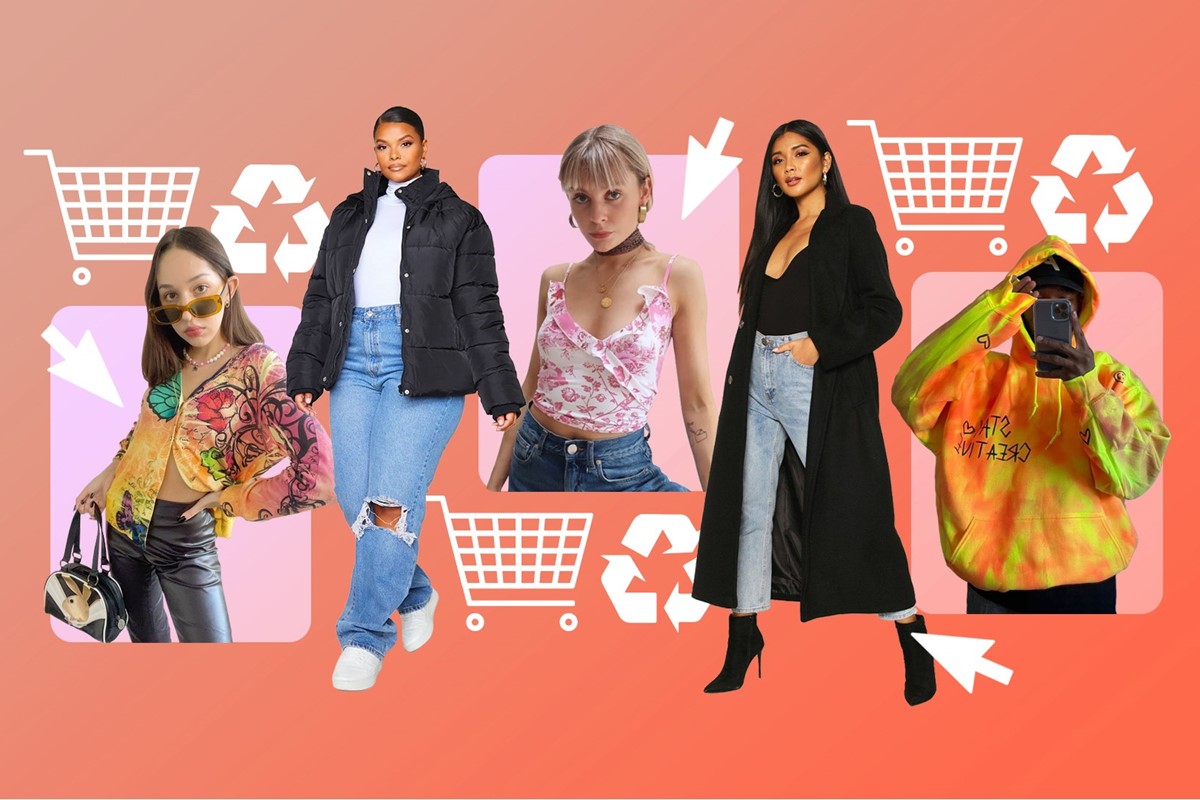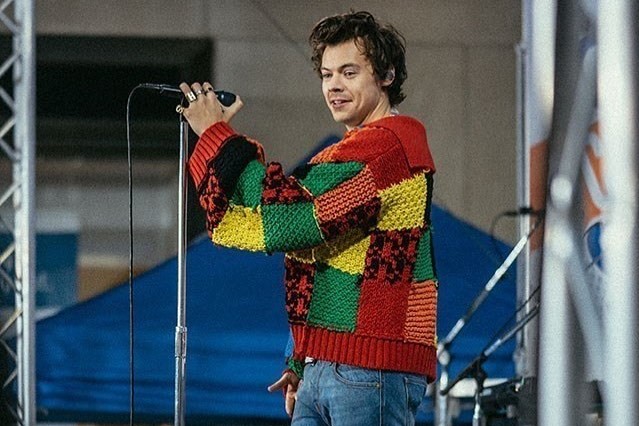
If Gen Z killed fast fashion, why is fast fashion still booming?
The number of people shopping second hand has soared in recent years – but for countless complex reasons, they’re not ready to ditch the Boohoo hauls just yet
“Shopping habits of generation Z could spell the end of fast fashion”; “Thrifting as rebellion: How Gen Z killed fast fashion”; “Gen Z is leading an evolution in shopping that could kill brands as we know them”. These headlines, and others like them, have peppered newspapers, business journals, and fashion publications across the course of the last 18 months. And they’re correct, to a point. As thredUP’s 2020 report revealed, the secondhand market is set to hit $64billion in the next five years, ultimately outpacing fast fashion by 2029 – and it’s Gen Z and millennials who are adopting secondhand faster than any other age group.
Reports like this are certainly reassuring when we’re increasingly exposed to the dark underbelly of the fast fashion industry, but they overlook one unmissable fact: fast fashion is booming. Arcadia going into administration, Forever21 filing for bankruptcy, and H&M making plans to shut 250 stores globally may seem to signal the beginning of the end for fast fashion but consumers have simply upped sticks and headed for even cheaper, faster e-commerce retailers.
Despite allegations about unsafe and unfair working conditions in its Leicester supplier factories, Boohoo’s sales rose by 45 per cent between February and August 2020, amid the height of the pandemic, with the number of shoppers rising by around a third, to 17.4 million. Around this time, internet searches for “cheap clothes” shot up 46 per cent, while Missguided saw sales of its loungewear climb 700 per cent, and people were more likely to search for clothing that cost under £5.
Job losses and low incomes may answer why some are embracing cheap fast fashion brands like Boohoo, Missguided, and Pretty Little Thing, which sold pieces for as little as 8p in its Black Friday sale. “The main reason I buy fast fashion items is because of the cost,” says author Zoe May. “Clothing that is made in a more ethical, local way, is often a lot more expensive so consumers like myself can feel priced out of being able to make that moral decision.”
17-year-old Rosa agrees. “The biggest reason (why I shop fast fashion) is that I’m very low income,” they say. “Another reason is I’m a fat person so my regular size is an XL, but I’m also autistic so I don’t wear that size due to sensory issues. I actually wear a 4 or 5XL most of the time and sustainable fashion pretty badly excludes these sizes.”
20-year-old Jessie also points to sensory issues as a driver for buying fast fashion. “I’m autistic and certain fabrics can trigger sensory overload for me,” they say. “I feel like sensory accessibility is not something many people consider when talking about making ethical fashion accessible to people. Returns, especially free ones, are vital for me to find clothes I can actually wear because I end up having to return a lot of stuff.”
From size inclusivity to income, many have inarguable reasons for turning to fast fashion. However, it’s not just those who need fast fashion that are causing the fast fashion boom. Plenty are still buying into it despite having the means to buy elsewhere, as illustrated beautifully when a model complained that her £18 Missguided jumpsuit had ruined her £60k Porsche.
“The ‘poor’ argument is intellectually dishonest,” fashion writer Aja Barber commented in 2020. “Fast fashion is a problem perpetuated by the middle class and wealthy. The poor do not collectively have the funds to keep this cycle extremely profitable.”
So why do so many continue to insist they cannot afford the alternatives to fast fashion when they’re making multiple purchases each month or week?
“People are not very good at maths, especially when being impulsive,” says Kate Nightingale, head consumer psychologist and founder of Style Psychology. “Also, the emotions and psychological benefit of five or six fast fashion pieces can be different than that of one or two sustainable pieces. We need a different way of marketing sustainability that goes way deeper into our psyche and fulfils other desires than just the one for being environmentally-friendly.”
“Clothing that is made in a more ethical, local way, is often a lot more expensive so consumers like myself can feel priced out of being able to make that moral decision” – Zoe May
Divergent desires may explain the many young people who don’t sit firmly in either camp, instead shopping both secondhand and fast fashion to fulfill different needs. For Claudia, 26, fast fashion is about convenience, availability, and price. “If I want a black roll neck long sleeved top, I can literally type that and (ASOS) gives me options. If I don’t go on there, where will I get things that I want specifics for?” But her shopping habits have her feeling conflicted. “If I was to buy it, it would be so on my conscience. So now as I’m learning more I’m like, “no I shouldn’t do this, but I really like this top!”,” she says.
“I’m really aware of the impact of fast fashion,” Claudia continues, citing both human rights issues and the “environmental perspective” as prompts to shop secondhand. “It’s so much better to give love to an item that’s already had a bit of a life, and it’s normally a bit more unique as well,” she says.
But for Claudia, secondhand alone simply doesn’t answer her needs. “I’d like to see the end of fast fashion, definitely. I just feel like second-hand is a bit all over the place really,” she says.
25-year-old Madeleine agrees. “My reasons for shopping fast fashion are ease of access, time saved, and lower costs,” she says. “And I know this is naughty because of the environmental impact but another reason is how easy it is to return items that don’t fit or suit you.”
Like Claudia, Madeleine cites “environmental reasons” for shopping secondhand, and she appreciates the higher quality of vintage items, buying jeans, shoes, and jumpers that are built to last. “I bought a pair of ‘vintage’ Pepe jeans from eBay for £12 and I guarantee they’ll outlast my ASOS ones,” she says.
She recently curbed her spending at ASOS after hearing how they treated their warehouse workers during lockdown but questions secondhand as a viable replacement for fast fashion. “I feel accessibility to secondhand fashionable items can be limited,” she says. “It can sometimes be a cash grab and the prices are massively inflated for what they are. Just look at Depop and the amount of Y2K items and their prices.”
Noticing the disconnect between Gen Z and millennials being pegged as the ‘woke’ generations who will save the world and them continuing to invest in fast fashion, Nikolas Rønholt, a Masters student at Aarhus University, set out to research the issue. Working with his colleague Malthe Overgaard, he interviewed consumers between the ages of 22 and 26, spanning the crossover between the Gen Z and Millennial age groups.
Offering the participants anonymity allowed them the freedom to be honest in their answers. “Liking the clothes is the most important thing,” one participant commented. “Then I begin to compromise with my other beliefs. If I believe a shirt from (a fast fashion brand) is nice, I buy it even though it is not sustainably produced – also because I can get it cheaply.”
This rationale echoes that of Sam*, who chose not to give their real name. “I shop fast fashion for selfish reasons really,” they told me. “I disagree with it and try to be environmentally conscious in the rest of my life. I use reusable water bottles and sanitary products, I don’t drive, and I avoid plastic where I can, but I still do it even though it’s not a financial necessity. It comes down to choice. I want to be able to browse 500 skirts in one place and buy and try heaps at once.”
Significantly, the anonymity that allows people to discuss the discordance between their values and their shopping habits may also enable them. “With low prices, easy return policies, and free delivery, marketers have significantly simplified the process of consumer’s purchasing decision. As a result, purchases completed online requires minimal cognitive consideration from the consumer,” says Rønholt.
“I shop fast fashion for selfish reasons really. I disagree with it and try to be environmentally conscious in the rest of my life. I use reusable water bottles and sanitary products, I don’t drive, and I avoid plastic where I can, but I still do it even though it’s not a financial necessity” – Sam*
Nightingale notes how e-commerce brands not only capitalise on anonymity but on the psychological traits and needs of their target market. “We need to bear in mind that Gen Z is currently at an age where they are still developing their identities”, she explains. “That means they need to try different skins on to learn who they are, who they want to be, and how people react to them in these various skins. That, coupled with their not fully developed impulse control, makes them more susceptible to a lot of these subconsciousness-affecting and impulsiveness-inducing tactics.”
Despite indulging in fast fashion, many consumers are aware of its impact and struggle to reconcile their purchases with their values. “The clothes become more expensive if it’s sustainable and that makes me disregard it, although I know that I probably should buy that instead of the t-shirt costing 30DKK (£3.63) on sale,” one of Rønholt’s interviewees noted.
“It’s something that really upsets me,” says Rosa. “Fast fashion being the only accessible fashion for me really isn’t right because I’m a climate activist and navigating that duality is weird.”
Ultimately, consumers want to see the changes coming from the brands. “Our findings reveal a paradoxical attitude among fast fashion consumers in the sense that although sustainability is disregarded in their fashion decisions, they still expected the fast fashion brands to promote sustainability,” says Rønholt.
Nine in ten Gen Z consumers believe companies have a responsibility to address environmental and social issues, but price – even when it’s not a necessity – continues to drive their decisions. So, it looks like it’s up to the brands to make sure every purchase is an ethical one. “It’s not a decision I should have to make in the first place,” says Jessie.



